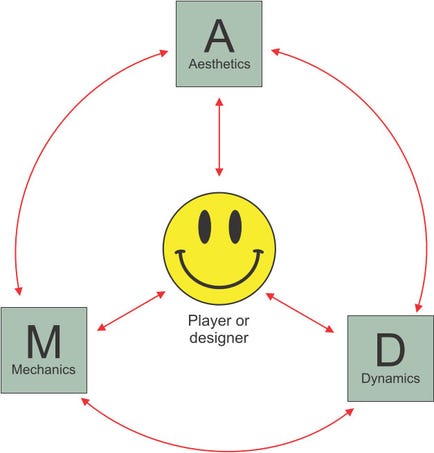
Featured Blog | This community-written post highlights the best of what the game industry has to offer. Read more like it on the Game Developer Blogs or learn how to Submit Your Own Blog Post
Revisiting the MDA framework
Can the MDA framework be expanded in order to accomodate non-digital games?

The MDA Framework
In the first years of the last decade, a trio of digital game designers — Robin Hunicke, Marc LeBlanc, and Robert Zubeck — created a conceptual perspective for game analysis that they called the MDA framework — where MDA stands for “Mechanics, Dynamics and Aesthetics” (Hunicke, LeBlanc and Zubeck 2004).
This framework has shown itself to be very influential, and it has since been used as the theoretical basis for several academic analysis of games. It has also been used as an analysis tool in game design courses.
The fundamental concept exposed by the MDA authors is that the components of a game can be categorized as follows:
“Mechanics describes the particular components of the game, at the level of data representation and algorithms.
Dynamics describes the run-time behavior of the mechanics acting on player inputs and each others outputs over time.
Aesthetics describes the desirable emotional responses evoked in the player, when she interacts with the game system.” (Hunicke, LeBlanc and Zubeck 2004).
One of the consequences of this analysis is offered by the MDA authors a few paragraphs below:
“From the designer’s perspective, the mechanics give rise to dynamic system behavior, which in turn leads to particular aesthetic experiences. From the player’s perspective, aesthetics set the tone, which is born out in observable dynamics and eventually, operable mechanics.” (Hunicke, LeBlanc and Zubeck 2004).
These symmetrical, complementary points of view are illustrated by a diagram (fig. 1) showing a linear alignment of the three categories.

Figure 1. Designers and players have different but symmetrical perspectives
(Hunicke, LeBlanc and Zubeck 2004).
The MDA authors are especially keen to point out that even small changes in mechanics can cascade throughout the other two levels, creating complex dynamic systems, often causing unexpected behavior in the games. This is the realm of emergent gameplay, which “occurs when interactions between objects in the game world or the player’s actions result in a second order of consequences that was not planned, or perhaps even predicted, by the game developers” (Sweetser 2008, p. 3).
Thus, Hunicke and her colleagues warn that seemingly trivial technical decisions in the level of coding and data representation will “trickle upward” and affect gameplay; on the other hand, the desired gameplay behavior will shape technical decisions in the design level.
The MDA framework is thus a tool to better understand games, since they are evaluated as dynamic systems, where each of the three levels of abstraction can affect the others.
MDA’s assumption
Although the MDA authors use Monopoly as one of the games they analyse, and although they also mention some other non-digital games in their paper, it seems that they are working essentially from a point of view shaped by their experience with digital games.
There seems to be a peculiar notion among digital game designers — akin to a blindness — whereby the word “game” applies almost exclusively to digital games. This is why, for instance, a respected game design manual states “dreams are where every game begins. Before the code, before the software plan, before the concept artwork, even before the first document...” (Rollings and Morris 2004, p. 6; my emphasis).
But of course digital games are only one part of the greater universe of games. Digital games are the new kids on a very ancient block; and, although they are also the richest kids in the neighborhood, there are several other kids around.
In the particular case of the MDA authors, this blindness causes an unexpected effect. Their assumption is that the player will always approach a new game from the aesthetic perspective, and from there he will proceed to the other planes, discovering the game dynamics and then learning the underlying mechanics. This assumption is evident in the second excerpt quoted above, and it was duly accepted by others who adopted the MDA proposal.
“Game designers only have direct control of the game’s mechanics; the mechanics work together to generate the dynamics, which in turn generate the aesthetics. They want to make their games fun and engaging, but only have indirect control of the player’s experience. Schreiber calls this a ‘second-order design problem’ and it’s the reason why game design is challenging. Thus, designers tend to see mechanics and work outwards.
Conversely, players are immediately familiar with their own emotional response to a game regardless of whether they understand the underlying rules. One can enjoy Wii Sports Tennis without necessarily knowing the exact dimensions of the virtual court. Only through hours of observation and deduction do the dynamics and mechanics gradually become clear.” (Gallant 2009, following on the steps of Schreiber 2009).
This assumption is indeed true for most digital games. Indeed, many games pride themselves in being “intuitive” — which means that the player will learn it as he plays, trying this and that until he gets a grasp of what works and what does not. Most players accept this and expect it.
The fact that many digital games fall in familiar genres also helps this perspective, shared by designers and players alike. For instance, one player used to play a first person shooter (FPS) game will already have an inkling of what to expect in another one: he has a rough idea of the user interface (UI), and he certainly knows what to expect from the gameplay. Game designers, of course, help this along by playing to these expectations, and rarely deviate from them.
Very often, games that present new challenges — in gameplay, in the UI, or other component of the player experience — offer devices such as tutorials, so as to ease the new player into the game. Some hardcore players, of course, pride themselves in never playing the tutorials and in learning the game “raw”.
Game manuals are rare, and even when they exist they often offer the bare minimum about the UI. For instance, the downloadable manual for Donkey Kong Jr., for the Nintendo 3DS, has one page (rather a column) of legal warnings, and one page (also a column) with the essential controls of the game. There is no mention of gameplay, how to proceed from one level to another — or even an acknowledgement that the game has levels.
The list of questions in the section “What the Player Needs to Know” of the already-quoted Game Architecture and Design (Rollings and Morris 2004, p. 204) does not mention rules or mechanics, but rather tells the designer to worry about how to show the player the game state and how to give player feedback for his actions. In short, how to help him learn what works and what does not. Something akin to this will be found in other game design manuals.
The assumption that underlies the MDA framework is thus well attested by facts. But, although this is a very common behavior, it is not a universal behavior, and this undermines the intent of the framework as a general tool for analyses of games.
Even in the realm of digital games there are some exceptions to this assumption. Complex strategy games, such as Europa Universalis III, or realistic simulators such as Silent Hunter III, must offer comprehensive documentation, or the players will not be able to play well, or at all.
Boardgames
As Salen and Zimmerman point out in their book Rules of Play: Game Design Fundamentals (Salen and Zimmerman 2004, p. 148), the implementation of rules is one of the main differences between the world of digital games and that of boardgames:
“In a non-digital game, the rules of a game are generally something that is concretely manifest in an instruction book or in the structure of the game materials. But with a digital game, the rules are buried in layers of program code and are often difficult to identify.”
Further to the point: in a digital game, the rules are implemented and enforced by the computer which runs the game. It acts as an impartial umpire (and much more, of course). But, in a boardgame, the players themselves must implement its rules and mechanics. It is impossible for a Chess novice to learn its rules simply by moving the men around on the board. There are no feedback systems for teaching him interactively.
In order to learn the rules of a bordgame at least one player must read the rules. If other players do not read them, he has the task of teaching them how to play. And, during the game, all players must implement the rules. This holds as true for Tic-Tac-Toe as for Chess.
This difference between digital games and boardgames is thus essential. The players of digital games can learn to play on the fly; but players of boardgames do not have this leisure. And thus, in boardgames, the assumption adopted by the MDA authors (and illustrated in figure 1) falls apart.
Sure, as it occurs with digital games, many players will be attracted to a new non-digital game by its theme — for instance, a game based on a famous TV show. But even so the player will not be able to experience the game until he learns the rules. His experience will start in the mechanics plane, and from there he will proceed to the other two planes.
But this progress will not be balanced. In the first few plays he will not be able to learn all the dynamics of the game; this will come in time, with repeated play, as in any other game. The aesthetic experience, however, will be immediately apparent even in the first plays — and he will very soon determine if he is having fun.
In fact, his progress in the dynamics plane will depend from his aesthetic perception in the first place, for if he does not think the game fun he will not be interested in furthering his mastery of its dynamics. On the other hand, when he is having fun, this fun can be heightened by mastering the dynamics of play.
And let's not forget that some people derive fun — and thus enjoyment in the MDA aesthetic plane — from the mechanics or dynamics themselves; for instance, there are people who are thrilled by any bluffing game.
The progression of the boardgame player through the MDA planes is thus not linear, and it is very different from the progression of the players of most digital games.
Going further
Is MDA broken? No, it is not. Its main use, as its authors propose, is in the “systematic coherence” which arises from the perception of how the three planes of abstraction interact in the process of game design. But this perception must not be bound by the linear model presented in that paper.
The experiences of the MDA authors shaped their original, linear model of the player interaction with the game. What the discussion above intends to show is that in fact there are games which, by their nature or their medium, do not conform themselves to this model.

Figure 2. A proposal for a new understanding of the MDA framework.
In fact, the linear progression postulated by the MDA authors is presented by them as one of the consequences of examining games through their perspective. The discussion above hopefully has shown that, while that progression is indeed one of the possibilities revealed by the MDA framework, it is not the only one. Rather, there is need for a more dynamic use of the model, one that is not constrained by that linearity.
In the field of design there is a growing perception of the usefulness of user-centered design, and this has led to methods of user participation in the design process (for instance, Vredenburg, Isensee, and Righi 2002). Of course the game design process has always depended very heavily on playtests, and these ideally should involve the prospective users; but it is a fact of the game industry that, because of time and money constraints, the tests are not as comprehensive as they should be.
The fact that the digital game industry seems to be in a rut has been pointed out by others; for instance, by Frank Lantz (in the preface to Salen and Zimmerman, 2004). There is a sore need for new perspectives.
The “blindness” mentioned above may be contributing to this. And the converse may hold true: if a digital game designer will take the time to learn more about games, and to think critically about games — not only digital games, but all kinds of games — perhaps this will help him design better games. In this sense, the MDA framework can certainly be used, but it must look beyond the digital games as well.
REFERENCES
Gallant, M., 2009. Mechanics, Dynamics & Aesthetics, <http://gangles.ca/2009/08/21/mda/>;. Accessed in January 24, 2014.
Hunicke, R.; Leblanc, M. & Zubek, R. A Formal Approach to Game Design and Game Research
Proceedings of the Challenges in Game AI Workshop, Nineteenth National Conference on Artificial Intelligence, 2004.
Rollings, A. and Morris, D., 2004. Game Architecture and Design. New Riders, Berkeley.
Salen, K., and Zimmerman, E., 2004. Rules of Play: Game Design Fundamentals. The MIT Press, Cambridge (MS).
Schreiber, I., 2009. Game Design Concepts. <http://gamedesignconcepts.wordpress.com/>;. Accessed in July 29, 2013.
Sweetser, P., 2008. Emergence in Games. Charles River Media, Boston.
Vredenburg, K., Isensee, S., and Righi, C., 2002. User-centered design: an integrated approach. Prentice Hall, New Jersey.
Read more about:
Featured BlogsAbout the Author(s)
You May Also Like







.jpeg?width=700&auto=webp&quality=80&disable=upscale)








